

Introduction ('Home')
Dismantling Phase
General Photographs
Pot Furnace Photographs
Tank Furnace Photographs
Annealing Oven Photographs
Tank Furnace and Oven Weathering
The fires were allowed to burn down on 15th May, 2005. Temperature loss was rapid at first but slowed down as the furnaces cooled. This was expected, and was prolonged by the continuing combustion of the charcoal in the firing chamber. Five days later, the ash in the pot furnace was still 80°C and in the tank furnace it was 47°C.
When cool, the grey-blue glaze on the insides of the furnaces could be seen. It was most likely due to the fluxing of the silica in the clay daub by sodium evaporated from the surface of the glass or by potassium from the woodash.
The small white spots visible on the interior surface are calcined shells introduced with the grit used as an ingredient in the daub. They caused no problem when the furnaces were hot, but now they are cold, we expect them to absorb moisture and cause the surface of the fired daub to spall. (In fact, the glaze prevented moisture from reaching the spots, so they remained intact during the period following the 2005 firing, and have shown no inclination to spall following the 2006 firing.)
As this was to be re-fired in 2006, we could not section this furnace. However, it was possible to observe the inside of both the pot and firing chambers.
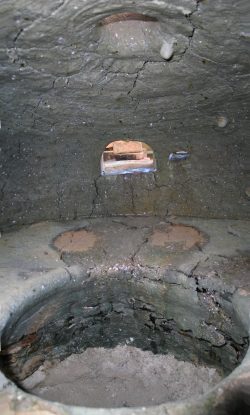
The blue-grey glazed pot chamber wall is noticeable. The cracks in the wall were due to shrinkage on firing, but did not affect the furnace performance during the three weeks. Some of the cracks extended through the wall (particularly at the gathering holes), and these may prove to be weak points in the 2006 firing. (They were not!)
The firing chamber wall has been attacked by the glass, particularly where it has run down the wall. In places, the thin coating of daub has either been dissolved or detached from the tiles behind it, allowing the glass to attack and glaze the tiles, reacting with the iron oxide within them to form a dark green colour.
The stoke hole shows a lot of wear and, in places, the daub has broken away to reveal the tiles behind it.
The ash in the firing chamber has been left, and the deposits will be added to in the 2006 firing. (In fact, we cleaned the ash out before the 2006 firing so as not to contaminate the ash produced in 2006.)
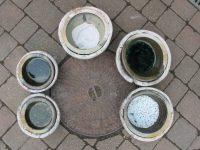
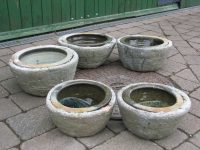
|
The pots experienced very little wear, and the two that failed probably cracked due to thermal shock (in the case of one pot, a hairline fracture was present before firing). The daub lining was partially successful, although the photographs show large cracks in three of the linings, and further experiments with different clay mixes may result in more success in preventing glass leakage.
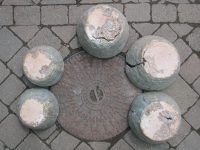
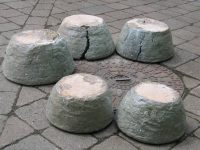
|
See this page for photographs of the pot furnace.
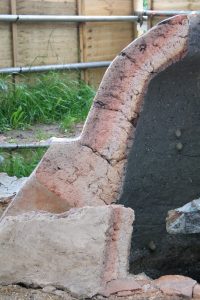
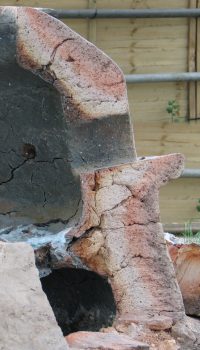
Using a saw, we sectioned this furnace to reveal the striking colour changes through the thickness of the wall. They are due to the temperature gradient through the wall as part of the heat loss process.
The areas of highest temperatures is the thin brown layer on the inside surface of the wall, thickening at the top of the gathering hole, where much of the hot waste gases exited.
The photographs show these colour changes. They also show the preservation of the handfuls of daub used to build the walls.
The tiles we exposed had shrunk and cracked on the portions facing into the firing chamber, indicating that they had been taken to a higher temperature than they had when originally fired.
The extent of damage to the tank was revealed: several large fissures had opened, providing exit points for the glass.
On emptying the ash and charcoal, a ring of compact ash was revealed adhering to the wall of the chamber. The firing chamber itself had been blackened through contact with charcoal and, possibly, also through reduction firing.
Under the contents of the firing chamber was the remains of the glass which had leaked from the tank. It had spread out into a large, flat pool about 1 - 1.5 cm thick. It was easy to remove as a thin layer of ash under it had prevented it from sticking to the floor of the chamber.
The stoke hole was partially fired and the stone floor had cracked.
See this page for photographs of the tank furnace.
The annealing oven did the job of annealing the vessels, but, along with the tank furnace, has been demolished and was replaced in 2006 by a stand-alone structure.
One point to note is that the tank furnace had to run at over 1000°C in order to heat the oven sufficiently, which is the minimum temperature needed to blow this type of glass. So, it would not have needed extra fuel to both blow glass and heat the oven. This means that it is possible to heat an oven this size using only waste heat from a furnace at least as big as the tank furnace.
See this page for photographs of the annealing oven.
We left the tank furnace, annealing oven and some of the broken section exposed to the elements, and monitored them from July to the following April.
Most of the early damage through the summer was caused by rain, coupled with bouts of drying from the wind and sun, particularly on the north-west facing side, which caught the prevailing wind. Clay particles were washed out first, leaving the hay, sand and grit in place, but this was gradually washed down by more rain.
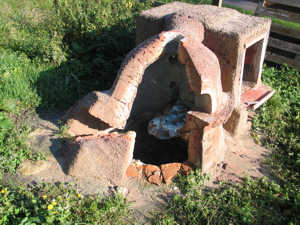 Weeds grew through the summer and autumn, and again in spring, but left a band of bare ground around the furnace where the extreme heat had sterilised the soil. Some plants germinated at the front of the stoke hole, and, in spring, in the pit.
Weeds grew through the summer and autumn, and again in spring, but left a band of bare ground around the furnace where the extreme heat had sterilised the soil. Some plants germinated at the front of the stoke hole, and, in spring, in the pit.
The increased rain through autumn and winter accounted for much of the weathering of the unfired surfaces, washing down more clay, followed by hay, sand and grit, which built up in layers at the base of the superstructures. The broken lumps on the ground weathered in the same way; the unfired clay turning to mud in the wet weather.
The freezing temperatures of late winter in the early part of 2006 acted upon the fired parts of the broken lumps on the ground, and the freeze-thaw action split them into small, sharp fragments, but the glazed areas were untouched.
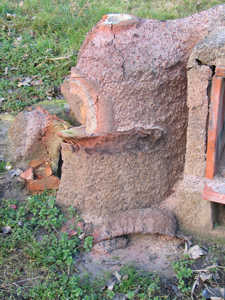 The frost action finally broke the shelf away from the side of the furnace, but none of the inner surfaces of the furnace were affected due to the shelter they had from the standing walls as well as being fired to a high temperature and having a waterproof glaze.
The frost action finally broke the shelf away from the side of the furnace, but none of the inner surfaces of the furnace were affected due to the shelter they had from the standing walls as well as being fired to a high temperature and having a waterproof glaze.
The oven withstood the weathering, although the unfired daub was heavily affected in the same way as that of the furnace. During the winter, even the sheltered side suffered and large cracks were formed by a combination of freeze-thaw and shrinking on drying after rain. These were increased in size by the washing action of the rain.
This led to very large holes appearing in some areas of the oven, where the daub met the tiles of the chamber, and where the oven was joined to the furnace. In these areas, large amounts of material washed down to ground level, where it piled against the sides.
So, unfired daub will wash away first, protecting the fired daub from attack until it is completely removed, allowing winter weather to attack the fired daub, eventually leaving a thin, very well fired layer which is glazed on its inside and more resistant to weathering. The material that is not completely washed away will build up in layers against the outer wall.
Weathering did not continue beyond this point as we demolished these structures in April, 2006! See this page for the 2006 firing.
See this page for photographs of the weathering process.
"If you build it, they will come."